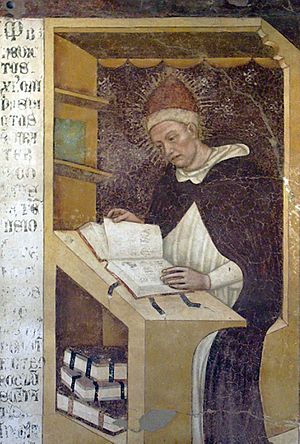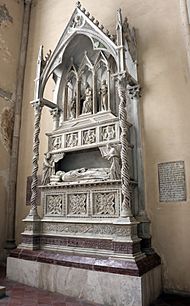Pope Benedict XI facts for kids
Quick facts for kids Pope Blessed Benedict XI |
|
|---|---|
| Bishop of Rome | |

A 1352 fresco by Tommaso da Modena at the church of Saint Nicholas in Treviso
|
|
| Church | Catholic Church |
| Papacy began | 22 October 1303 |
| Papacy ended | 7 July 1304 |
| Predecessor | Boniface VIII |
| Successor | Clement V |
| Orders | |
| Ordination | 1300 |
| Consecration | March 1300 |
| Created Cardinal | 4 December 1298 |
| Personal details | |
| Birth name | Nicola Boccasini |
| Born | 1240 Treviso, Italy |
| Died | 7 July 1304 (aged 63–64) Perugia, Papal States |
| Previous post |
|
| Motto | Illustra faciem Tuam super servum Tuum (Latin for 'Let Your Face shine upon Your servant') |
| Coat of arms |  |
| Sainthood | |
| Feast day | 7 July |
| Beatified | 24 April 1736 Rome, Papal States by Pope Clement XII |
| Attributes |
|
| Patronage | Treviso |
| Other Popes named Benedict | |
Pope Benedict XI (born Nicola Boccasini) was the leader of the Catholic Church and ruler of the Papal States from October 1303 until his death in July 1304. He was born in 1240 in Treviso, Italy.
Nicola Boccasini joined the Dominican Order, a group of Catholic priests and brothers, in his hometown. He studied in Venice and Milan. Later, he became a teacher in Venice and other Dominican centers. He served as a leader for the Dominicans in Lombardy twice. In 1296, he was chosen as the Master of the entire Dominican Order.
Two years later, he became a cardinal. He was appointed Bishop of Ostia. He also served as a special representative for the Pope in Hungary and France. He was with Pope Boniface VIII when the Pope was attacked by French forces in Anagni.
Pope Clement XII declared him "Blessed" in 1736. This means he is honored for his holy life. He is a special protector of Treviso.
Contents
Early Life and Education
Nicola Boccasini was born in Treviso. His father, Boccasio, was a notary, and his mother, Bernarda, worked as a laundress. Nicola had a sister named Adelette.
When Nicola was six, his family received money from a Dominican friar's will. This money came with a condition: if Nicola joined the Dominican Order, he would get half of it. This suggests he was meant for a religious life from a young age.
He joined the Order of Preachers in 1254, when he was 14. He began his training in Treviso. He then went to Venice for his basic education. During this time, he also taught the young sons of a noble family in Venice.
In 1262, Nicola moved to Milan to study further. He spent six years there. After this, he became a teacher for other brothers in the Dominican convent in Venice. He taught for 14 years, from 1268 to 1282. He also taught in Treviso and Genoa. Nicola was one of the last popes who did not have a university degree.
Important Roles and Leadership
In 1286, Nicola was chosen as the Provincial Prior of Lombardy. This meant he was in charge of all the Dominican convents in that region. There were about 51 convents in Lombardy at the time. His job involved visiting these convents to check on them and offer guidance.
He also had the important role of an Inquisitor. This was a task where popes trusted Franciscans and Dominicans to investigate matters of faith. He also organized meetings for the Dominican leaders in his region. After three years, he finished his term as Provincial.
He was elected Provincial Prior of Lombardy again in 1293. He served in this role until 1296.
Leading the Dominican Order
In 1296, Nicola of Treviso was elected Master of the Order of Preachers. This meant he was the head of the entire Dominican Order worldwide. He made rules that no Dominican should question if Pope Boniface VIII was truly elected Pope.
Becoming a Cardinal
Pope Boniface VIII made Boccasini a cardinal on December 4, 1298. He was given the title of Cardinal-Priest of Santa Sabina. This meant he became a close advisor to the Pope.
On March 2, 1300, he was promoted to Cardinal-Bishop of Ostia. He also became a bishop. He was then sent as a special representative, called an papal legate, to Hungary in 1301. He also served as a papal legate to France.
In September 1303, Pope Boniface VIII was attacked in Anagni. Cardinal Boccasini was one of only two cardinals who stayed to defend the Pope. They were held captive for three days. Later, they were freed and returned to Rome with the Pope.
His Time as Pope
Becoming Pope
After Pope Boniface VIII died, the cardinals met to choose a new Pope. This meeting is called a conclave. They wanted someone who would not be against King Philip IV of France. Nicola Boccasini was chosen as the new Pope after just one vote. He took the name Benedict XI.
Key Actions as Pope
Pope Benedict XI quickly lifted the excommunication on King Philip IV. Excommunication is a serious church punishment that removes someone from the Church. However, on June 7, 1304, Benedict XI excommunicated Guillaume de Nogaret, a minister of King Philip IV, and others who had attacked his predecessor, Pope Boniface VIII.
Benedict XI also helped arrange a truce, or armistice, between King Philip IV of France and Edward I of England.
Pope Benedict XI died suddenly in Perugia after being Pope for only eight months. Some people suspected he was poisoned, possibly by Nogaret. However, there is no clear proof of this. The next Pope, Pope Clement V, was in France when he was elected. He never went to Rome. This started a period where Popes lived in Avignon, France, known as the Avignon Papacy. These popes were often influenced by the French kings.
Benedict XI also appointed three new cardinals during his time as Pope. All three were members of the Dominican Order, just like him.
He also wrote several books, including sermons and comments on parts of the Bible.
Interesting Stories
There is a story about Pope Benedict XI. One Easter, he was celebrating Mass when a pilgrim interrupted him. The pilgrim wanted to confess his sins. Instead of telling him to wait, the Pope stopped the Mass, heard the confession, and then continued the service. This story shows his kindness and dedication.
Another story says that a friar once predicted that Nicola would become a Provincial leader, then Master General of his Order, then a Cardinal, and finally, Pope.
Becoming a Blessed Saint
Benedict XI was known for his holy life. Many people respected him. After his death, miracles were reported at his tomb. In 1736, Pope Clement XII officially approved his veneration. This means he was formally declared "Blessed." Later, in 1748, his veneration was extended to the region of Venice.
Why is he Benedict XI?
You might wonder why he is called Benedict XI if he was the tenth Pope named Benedict. This is because an earlier Pope, Benedict X (who lived from 1058–1059), is now considered an "antipope" by the Catholic Church. An antipope is someone who claims to be Pope but is not officially recognized. However, at the time Benedict XI was elected, Benedict X was still considered a legitimate Pope. So, Nicola Boccasini took the number XI instead of X. This means all Popes Benedict after him have their number increased by one.
See also
 In Spanish: Benedicto XI para niños
In Spanish: Benedicto XI para niños


